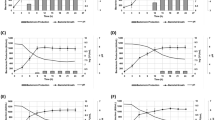Abstract
A 24-membered ring macrolide compound, macrolactin A has potential applications in pharmaceuticals for its anti-infectious and antiviral activity. In this study, macrolactin A was produced by a marine bacterium, which was identified as Bacillus subtilis by 16S ribosomal RNA (rRNA) sequence analysis. Electrospray ionization mass spectrometry (ESI/MS) and nuclear magnetic resonance (NMR) spectroscopy analyses were used to characterize this compound. To improve the production, response surface methodology (RSM) involving Box-Behnken design (BBD) was employed. Faeces bombycis, the main by-product in sericulture, was used as a nitrogen source in fermentation. The interactions between three significant factors, F. bombycis, soluble starch, and (NH4)2SO4 were investigated. A quadratic model was constructed to fit the production and the factors. Optimum medium composition was obtained by analysis of the model. When cultivated in the optimum medium, the production of macrolactin A was increased to 851 mg/L, 2.7 times as compared to the original. This study is also useful to find another way in utilizing F. bombycis.
Similar content being viewed by others
References
Bärmann, H., Prahlad, V., Tao, C., Yun, Y.K., Wang, Z., Donaldson, W.A., 2000. Development of organoiron methodology for preparation of the polyene natural product macrolactin A. Tetrahedron, 56(15):2283–2295. [doi:10.1016/S0040-4020(99)01111-4]
Deepak, V., Kalishwaralal, K., Ramkumarpandian, S., 2008. Optimization of media composition for Nattokinase production by Bacillus subtilis using response surface methodology. Bioresour. Technol., 99(17):8170–8174. [doi:10.1016/j.biortech.2008.03.018]
Demain, A.L., 2006. From natural products discovery to commercialization: a success story. J. Ind. Microbiol. Biotechnol., 33(7):486–495. [doi:10.1007/s10295-005-0076-x]
Gao, H., Liu, M., Liu, J., Dai, H., Zhou, X., Liu, X., Zhuo, Y., Zhang, W., Zhang, L., 2009. Medium optimization for the production of avermectin B1a by Streptomyces avermitilis 14-12A using response surface methodology. Bioresour. Technol., 100(17):4012–4016. [doi:10.1016/j.biortech.2009.03.013]
Gustafson, K., Roman, M., Fenical, W., 1989. The macrolactins, a novel class of antiviral and cytotoxic macrolides from a deep-sea marine bacterium. J. Am. Chem. Soc., 111(19):7519–7524. [doi:10.1021/ja00201a036]
Mutalik, S.R., Vaidya, B.K., Joshi, R.M., Desai, K.M., Nene, S.N., 2008. Use of response surface optimization for the production of biosurfactant from Rhodococcus spp. MTCC 2574. Bioresour. Technol., 99(16):7875–7880. [doi:10.1016/j.biortech.2008.02.027]
Romero-Tabarez, M., Jansen, R., Sylla, M., Lünsdorf, H., Häußler, S., Santosa, D., Timmis, K., Molinari, G., 2006. 7-O-malonyl macrolactin A, a new macrolactin antibiotic from Bacillus subtilis active against methicillin-resistant Staphylococcus aureus, vancomycin-resistant Enterococci, and a small-colony variant of Burkholderia cepacia. Antimicrob. Agents Chemother., 50(5):1701–1709. [doi:10.1128/AAC.50.5.1701-1709.2006]
Sambrook, J., Maniatis, T., 1989. Molecular Cloning: A Laboratory Manual, 2nd Ed. Cold Spring Harbor Laboratory Press, Cold Spring Harbor, NY, USA, p.23–38.
Syed, D.G., Lee, J.C., Li, W.J., Kim, C.J., Agasar, D., 2009. Production, characterization and application of keratinase from Streptomyces gulbargensis. Bioresour. Technol., 100(5):1868–1871. [doi:10.1016/j.biortech.2008.09.047]
Thompson, J.D., Higgins, D.G., Gibson, T.J., 1994. CLUSTALW: improving the sensitivity of progressive multiple sequence alignment through sequence weighting, position-specific gap penalties and weight matrix choice. Nucleic Acid Res., 22(22):4673–4680. [doi:10.1093/nar/22.22.4673]
Wei, Z.J., Liao, A.M., Zhang, H.X., Liu, J., Jiang, S.T., 2009. Optimization of supercritical carbon dioxide extraction of silkworm pupal oil applying the response surface methodology. Bioresour. Technol., 100(18):4214–4219. [doi:10.1016/j.biortech.2009.04.010]
Wei, Z.J., Zhou, L.C., Chen, H., Chen, G.H., 2011. Optimization of the fermentation conditions for 1-deoxynojirimycin production by Streptomyces lawendulae applying the response surface methodology. Int. J. Food Eng., 7(3):1–10. [doi:10.2202/1556-3758.2354]
Yang, H., Zhu, X., Fang, Z., 2002. Research progress on exploiting and utilizing of silkworm Feces. Bull. Seric., 33(3):9–12 (in Chinese).
Zhang, H., Li, J.L., Li, C.X., Feng, L.J., 1999. Multiple utilization of Faeces bombycis in current and future. Liaoning Agric. Sci., 4:24–26 (in Chinese).
Zhang, Y., Li, Q., Zhang, Y., Wang, D., Xing, J., 2012. Optimization of succinic acid fermentation with Actinobacillus succinogenes by response surface methodology (RSM). J. Zhejiang Univ-Sci. B (Biomed. & Biotechnol.), 13(2):103–110. [doi: 10.1631/jzus.B1100134]
Author information
Authors and Affiliations
Corresponding authors
Additional information
Project supported by the Science and Technology Department of Zhejiang Province, China (No. 2009C33019), the Industry-University-Research Institution Alliance for Microbial Medicine Technology Innovation and New Drug Development of China (No. 2010ZX090401-403), and the National Science and Technology Major Project of New Drug of China (Nos. 2011ZX09201-101 and 2012ZX09103101-075)
Rights and permissions
About this article
Cite this article
Chen, H., Wu, Mb., Chen, Zj. et al. Enhancing production of a 24-membered ring macrolide compound by a marine bacterium using response surface methodology. J. Zhejiang Univ. Sci. B 14, 346–354 (2013). https://doi.org/10.1631/jzus.B1200153
Received:
Accepted:
Published:
Issue Date:
DOI: https://doi.org/10.1631/jzus.B1200153
Key words
- 24-membered ring macrolide
- Enhancing production
- Response surface methodology
- Faeces bombycis
- Marine bacterium




